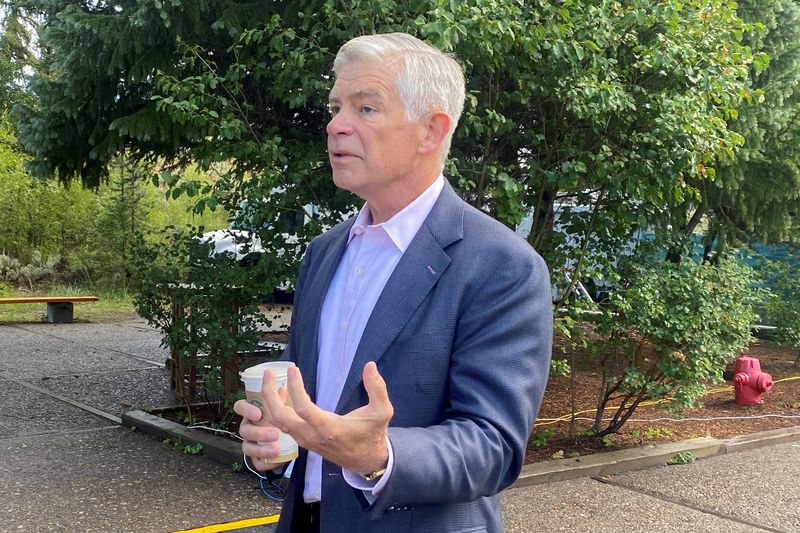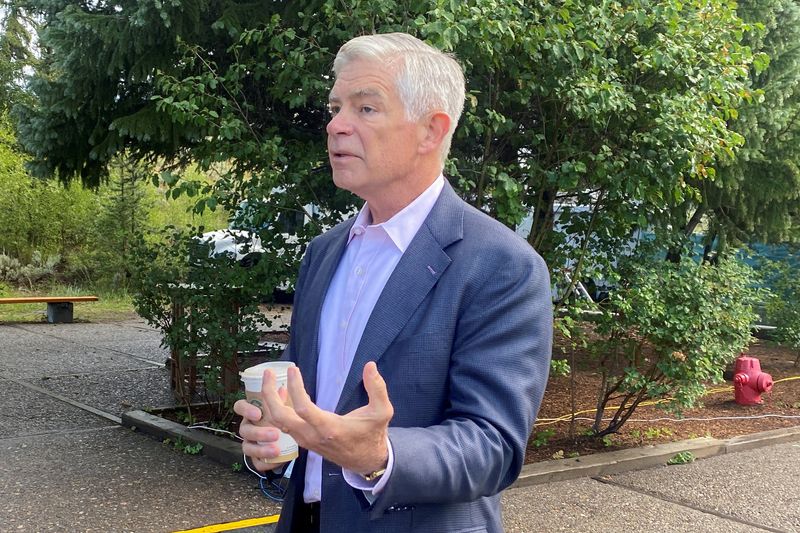Economy
Fed’s Harker expects no more rate hikes needed this year, in CNBC interview


© Reuters. FILE PHOTO: Philadelphia Federal Reserve Bank President Patrick Harker speaks with CNBC’s Steve Liesman (not pictured) after an interview ahead of the annual Kansas City Fed Economic Policy Symposium, in Jackson Hole, Wyoming, U.S., August 25, 2022. REUTE
By Michael S. Derby
NEW YORK (Reuters) -Federal Reserve Bank of Philadelphia President Patrick Harker doubts the U.S. central bank will need to raise interest rates again, and said in an interview with CNBC he’s not ready to predict when the Fed can start lowering rates.
“Right now I think that we’ve probably done enough” and it’s probably a good idea to hold steady for the rest of this year and see how that affects the economy, Harker said on Thursday.
“We are in a restrictive stance, do we have to keep going even more and more restrictive?” Harker asked. “I’m in the camp of let the restrictive stance work for a while, let’s just let this play out for a while, and that should bring inflation down.”
Harker spoke to the television channel on the sidelines of the Kansas City Fed’s annual research conference in Jackson Hole, Wyoming. He was the first Fed official to weigh in ahead of a hotly anticipated speech Fed Chair Jerome Powell is scheduled to give on Friday morning.
Harker is a voting member of the rate-setting Federal Open Market Committee. That body meets next month and there is considerable uncertainty over whether it will follow its July rate rise with another increase then.
The Fed started raising its overnight target rate aggressively in March 2022 as it sought to tame the worst surge of inflation seen in decades. Over recent months it has slowed the pace of those increases and now has its target at between 5.25% and 5.50%.
Questions about the outlook for policy are being driven by the fact that inflation has been moderating but still remains too high relative to the central bank’s 2% objective, in the view of many Fed policymakers. At the same time, the job market remains very strong and growth has been particularly resilient, which suggests that even as price pressures have fallen the Fed has space to boost rates further to lower inflation.
But for Harker, it’s very much a question of the economy working through the ongoing impact of the Fed’s prior actions. “What I’ve heard loud and clear through my summer travels is, ‘please, you’ve gone up very rapidly. We need to absorb that,'” the bank president said of his local contacts.
Harker said in his appearance he sees inflation cooling to 4% this year, 3% next year and back to the 2% goal in 2025. He expects the unemployment rate to rise a touch to 4% or maybe higher and he believes growth should moderate.
Harker also said the surge in long-term borrowing costs seen lately might help moderate activity, while noting he’s watching the situation for any possible trouble.
Harker also said it’s too soon to say when the Fed might cut interest rates. He said inflation would need to cool further “before I’d be willing to make a cut.”
Economy
Russian central bank says it needs months to make sure CPI falling before rate cuts -RBC


© Reuters. Russian Central Bank Governor Elvira Nabiullina attends a news conference in Moscow, Russia June 14, 2019. REUTERS/Shamil Zhumatov/File Photo
MOSCOW (Reuters) – Russia’s central bank will need two to three months to make sure that inflation is steadily declining before taking any decision on interest rate cuts, the bank’s governor Elvira Nabiullina told RBC media on Sunday.
The central bank raised its key interest rate by 100 basis points to 16% earlier in December, hiking for the fifth consecutive meeting in response to stubborn inflation, and suggested that its tightening cycle was nearly over.
Nabiullina said it was not yet clear when exactly the regulator would start cutting rates, however.
“We really need to make sure that inflation is steadily decreasing, that these are not one-off factors that can affect the rate of price growth in a particular month,” she said.
Nabiullina said the bank was taking into account a wide range of indicators but primarily those that “characterize the stability of inflation”.
“This will take two or three months or more – it depends on how much the wide range of indicators that characterize sustainable inflation declines,” she said.
The bank will next convene to set its benchmark rate on Feb. 16.
The governor also said the bank should have started monetary policy tightening earlier than in July, when it embarked on the rate-hiking cycle.
Economy
China identifies second set of projects in $140 billion spending plan


© Reuters. FILE PHOTO: Workers walk past an under-construction area with completed office towers in the background, in Shenzhen’s Qianhai new district, Guangdong province, China August 25, 2023. REUTERS/David Kirton/File Photo
SHANGHAI (Reuters) – China’s top planning body said on Saturday it had identified a second batch of public investment projects, including flood control and disaster relief programmes, under a bond issuance and investment plan announced in October to boost the economy.
With the latest tranche, China has now earmarked more than 800 billion yuan of its 1 trillion yuan ($140 billion) in additional government bond issuance in the fourth quarter, as it focuses on fiscal steps to shore up the flagging economy.
The National Development and Reform Commission (NDRC) said in a statement on Saturday it had identified 9,600 projects with planned investment of more than 560 billion yuan.
China’s economy, the world’s second largest, is struggling to regain its footing post-COVID-19 as policymakers grapple with tepid consumer demand, weak exports, falling foreign investment and a deepening real estate crisis.
The 1 trillion yuan in additional bond issuance will widen China’s 2023 budget deficit ratio to around 3.8 percent from 3 percent, the state-run Xinhua news agency has said.
“Construction of the projects will improve China’s flood control system, emergency response mechanism and disaster relief capabilities, and better protect people’s lives and property, so it is very significant,” the NDRC said.
The agency said it will coordinate with other government bodies to make sure that funds are allocated speedily for investment and that high standards of quality are maintained in project construction.
($1 = 7.1315 renminbi)
Economy
Russian central bank says it needs months to make sure CPI falling before rate cuts -RBC


© Reuters. Russian Central Bank Governor Elvira Nabiullina attends a news conference in Moscow, Russia June 14, 2019. REUTERS/Shamil Zhumatov/File Photo
MOSCOW (Reuters) – Russia’s central bank will need two to three months to make sure that inflation is steadily declining before taking any decision on interest rate cuts, the bank’s governor Elvira Nabiullina told RBC media on Sunday.
The central bank raised its key interest rate by 100 basis points to 16% earlier in December, hiking for the fifth consecutive meeting in response to stubborn inflation, and suggested that its tightening cycle was nearly over.
Nabiullina said it was not yet clear when exactly the regulator would start cutting rates, however.
“We really need to make sure that inflation is steadily decreasing, that these are not one-off factors that can affect the rate of price growth in a particular month,” she said.
Nabiullina said the bank was taking into account a wide range of indicators but primarily those that “characterize the stability of inflation”.
“This will take two or three months or more – it depends on how much the wide range of indicators that characterize sustainable inflation declines,” she said.
The bank will next convene to set its benchmark rate on Feb. 16.
The governor also said the bank should have started monetary policy tightening earlier than in July, when it embarked on the rate-hiking cycle.

 Forex3 years ago
Forex3 years agoForex Today: the dollar is gaining strength amid gloomy sentiment at the start of the Fed’s week

 Forex3 years ago
Forex3 years agoUnbiased review of Pocket Option broker

 Forex3 years ago
Forex3 years agoDollar to pound sterling exchange rate today: Pound plummeted to its lowest since 1985

 Forex3 years ago
Forex3 years agoHow is the Australian dollar doing today?

 Cryptocurrency3 years ago
Cryptocurrency3 years agoWhat happened in the crypto market – current events today

 World3 years ago
World3 years agoWhy are modern video games an art form?

 Commodities3 years ago
Commodities3 years agoCopper continues to fall in price on expectations of lower demand in China

 Economy3 years ago
Economy3 years agoCrude oil tankers double in price due to EU anti-Russian sanctions





















